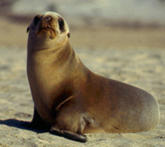California Sea Lion (Zalophus californianus)
Status | Taxonomy | Species Description | Habitat | Distribution |
Population Trends | Threats | Conservation Efforts | Regulatory Overview |
Key Documents | More Info
Status
MMPA - California sea lions, like all marine mammals, are protected under the MMPA.
Taxonomy
Kingdom: Animalia
Phylum: Chordata
Class: Mammalia
Order: Carnivora
Family: Otariidae
Genus: Zalophus
Species: californianus
Species Description
California sea lions are members of the "eared seal" family, Otariidae. They are the most recognized pinniped species, because they are commonly seen doing acrobatic tricks in shows at zoos and aquariums. Male California sea lions have a robust body while females and juveniles have a more slender body. They have broad foreflippers and a long, narrow snout. Males have a broad forehead. Their coats are dark brown with females being slightly lighter in color.
California sea lions are sexually "dimorphic" with males reaching average lengths of 7.5 ft (2.25 m) and weighing about 700 lbs (315 kg). Some large males exceed 1,000 lbs (455 kg). Females are much smaller, reaching average lengths of 6 ft (2 m) and weighing about 240 lbs (110 kg). They have a lifespan of 20 to 30 years.
California sea lions are social animals and form groups of several hundred individuals onshore. They are fast, agile swimmers and are often seen porpoising and wave riding. The deepest dive ever recorded for a California sea lion is 1,760 ft (535 m).
Males are "polygamous" establishing breeding territories that may include up to fourteen females. They defend their territories with aggressive physical displays and vocalization. Sea lions reach sexual maturity at 4-5 years old. Breeding season lasts from May to August while most pups are born from May through July. Three weeks after giving birth, females are ready to mate again. Pups are weaned at 10 months old.
California sea lions feed mainly in upwelling areas on a variety of prey such as squid anchovies, mackerel, rockfish, and sardines. They also take fish from commercial fishing gear, sport-fishing lines, and at fish passage facilities at dams and rivers.
Habitat
California sea lions reside in the Eastern North Pacific Ocean in shallow coastal and estuarine waters. Sandy beaches are preferred for haul out sites. In California, they haul out on marina docks as well as jetties and buoys.
Distribution
California sea lions range from the Pacific coast of Central Mexico north to British Columbia, Canada. Their primary breeding range is from the Channel Islands in Southern California to Central Mexico. There is one stock of California sea lions in U.S. waters that ranges from the U.S./Mexico border and extends to Canada.
Population Trends
The current estimated population status for the U.S. stock of California sea lions is 244,000 animals. The population trend for California sea lion pups has been increasing since 1975 and is currently at its "optimum sustainable population".
Threats
A primary threat to California sea lions is incidental catch and entanglement in fishing gear, such as gillnets. Recently, mortalities have been linked to biotoxins as a result of harmful algal blooms. California sea lions are sometimes viewed as a nuisance by commercial fishermen and there are records of stranded sea lions with gunshot wounds and other human-caused injuries.
Conservation Efforts
California sea lions are classified as Low Risk-Least Concern on the IUCN Red List ![]() .
.
Regulatory Overview
This species is protected under the Marine Mammal Protection Act of 1972, as amended.
Key Documents
(All documents are in PDF format.)
| Title | Federal Register | Date |
|---|---|---|
| Stock Assessment Reports | n/a | various |
- NMFS National Marine Mammal Laboratory California Sea Lion Information and Research
- NMFS Southwest Fisheries Science Center California Sea Lion Information
- NMFS Southwest Regional Office: CA Pinniped Rookeries and Haul-out Sites
- NMFS Northwest Regional Office Safely Deterring Seals & Sea Lions
- NOAA's National Marine Sanctuaries
- Ocean Biogeographic Information System (OBIS-SEAMAP) California Sea Lion Species Profile

